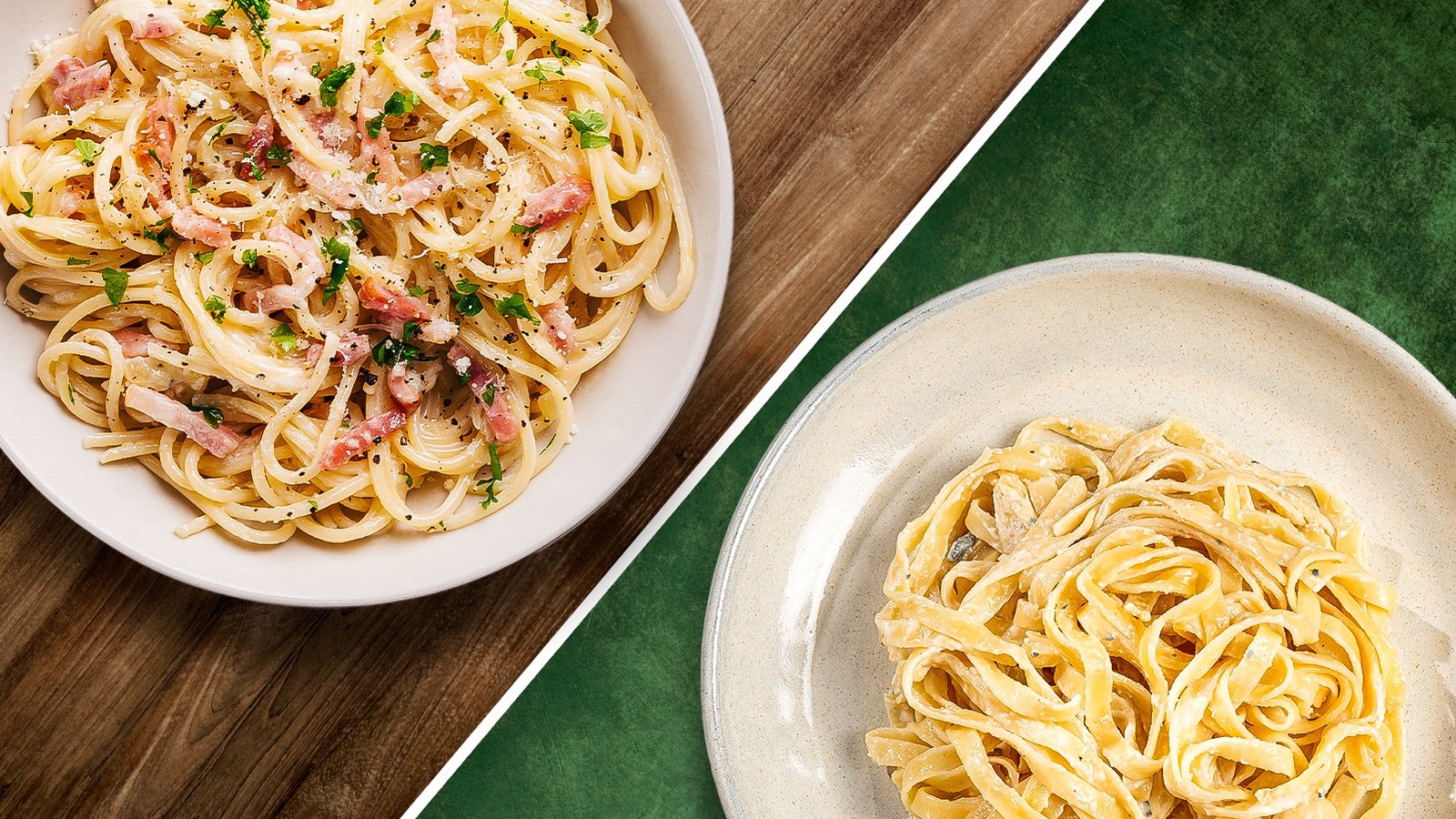At first glance carbonara and Alfredo seem as similar as two pasta dishes can be, but their differences show just how meaningful small changes to recipes can be. The two represent different versions of Italian tradition, with carbonara standing in as the simple, rustic dish taking full advantage of the Italian predilection for sticking with fresh local ingredients, and Alfredo taking the more maximalist Italian-American route. Still, when the cooking is done, they both get set down as smooth, cheesy pastas that are made to fill stomachs as a hearty weeknight dinner.
Outside of the cheese, carbonara and Alfredo are actually quite different experiences, both in how they taste and how they’re made. Despite the creaminess of both dishes, the biggest difference in ingredients is that the sauce for carbonara isn’t dairy based at all. Alfredo, on the other hand, is a wildly rich combination that involves butter and cream as the base of the sauce. Taste them side by side, and Alfredo the much heavier of the two, with carbonara having a lighter more delicate sauce that eschews the rich dairy flavor of Alfredo for a more salty and complex flavor. Carbonara also happens to be the more challenging of the two to make, requiring a delicate management of heat and ingredients to achieve that lighter texture. Alfredo is much simpler and an easy Italian-style pasta dish to master even for beginners. But like any pasta favorite, which one you choose is up to you and only you.
What is carbonara?
Carbonara is a simple Italian pasta sauce that is only made from three primary ingredients: cheese, guanciale (cured pork jowl), and eggs, with black pepper also being a major flavor addition. There is some dispute over the origins of carbonara, because recipes for it didn’t start appearing until the 1950s. Some say it was invented in Italy by Americans who were serving as GIs after World War Two, and the first published recipe was in an American cookbook. However, the author of that cookbook was from Italy, and there is evidence for pasta like carbonara being made in Italy long before that era. Regardless of where it’s from, carbonara is now considered one of the four classic Roman pastas along with cacio e pepe and amatriciana, which share similar ingredients.
Simple spaghetti carbonara gets its silky texture from the eggs, which must be delicately incorporated into the cooked pasta without getting hot enough to be scrambled. The guanciale is rendered in a pan to cook out the fat, and then mixed with cooked pasta. The eggs are beaten and mixed with the grated cheese, usually a mix of Pecorino-Romano and Parmigiano-Reggiano, then tossed with the pasta off heat to cook the eggs more gently. This should form a smooth emulsion of the rendered fat and egg, which coats the pasta, and may be thinned out with splashes of pasta water. The guanciale adds a strong salty and cured flavor to the creamy sauce, while lots of black pepper give it bite.
What is Alfredo?
Despite its now-American reputation, Alfredo also originated in Italy, but in a slightly different version, and it has since morphed into the cream-based sauce we know so well in the U.S. It got its name from its creator, Alfredo di Lelio, who made a fettuccine dish with butter and grated parmesan for his sick wife. The dish eventually made its way onto the menu at a Roman restaurant opened by Alfredo, and became popular among American tourists in the 1920s, including silent film stars Mary Pickford and Douglas Fairbanks, who helped launch its fame stateside.
Once it became an American dish it changed and added a few ingredients, the most important being cream. Alfredo sauce is now made with a mixture of butter and cream and flavored with grated parmesan, garlic, and occasionally nutmeg. It’s also usually garnished with parsley instead of black pepper. The butter and cream mixture is cooked down with the garlic to achieve the thick texture, a much less error-prone way to achieve that rich texture than carbonara’s emulsion. The cheese and other flavorings are then whisked in at the end.
Unlike carbonara, which is usually served with tubular pasta, like spaghetti or bucatini, the flat fettuccine is still the preferred shape for Alfredo. Without the pork and pepper and with the cream, Alfredo has a much thicker, richer flavor, than carbonara with less salt and spice. But the Italian-American mac-and-cheese style of Alfredo still has an appeal all its own.






